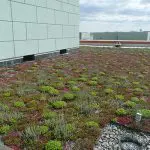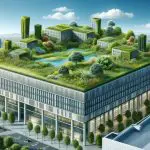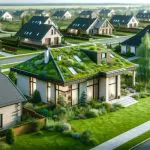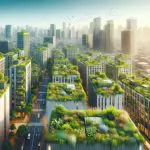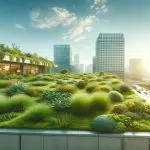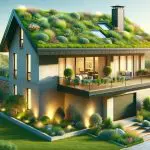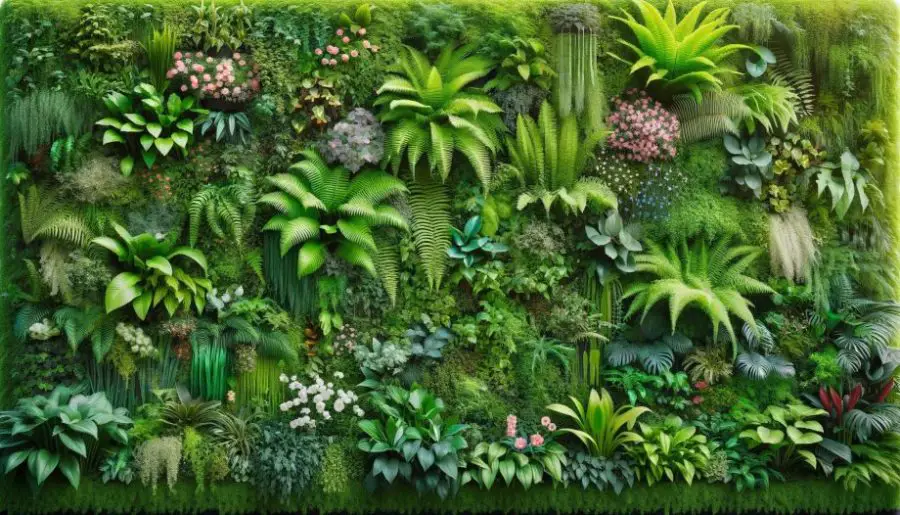
Explore the world of green roofs and living walls, innovative solutions blending nature with urban architecture for a sustainable and beautiful future.
Green Roofs and Living Walls Key Takeaways:
- Green roofs and living walls are eco-friendly architectural elements that integrate vegetation into urban structures.
- Green roofs cover rooftops with plants, reducing heat and improving air quality.
- Living walls are vertical gardens on building exteriors, offering aesthetic beauty and environmental benefits.
Welcome to the fascinating realm of green roofs and living walls where nature meets urban design.
These innovative features are not just visually stunning; they’re pivotal in creating sustainable, eco-friendly spaces in our cities.
In this journey, we’ll uncover how they’re transforming our urban landscapes, offering an array of environmental, health, and aesthetic benefits.
Understanding Green Roofs and Living Walls
As we delve into the world of green roofs and living walls we find innovative approaches merging architecture with nature.
These sustainable features are reshaping our urban landscapes, providing a harmonious blend of aesthetics and ecology.
This section will explore their fundamentals, types, and significance in modern urban design.
Overview of Green Roofs and Living Walls
Green roofs and living walls represent a paradigm shift in urban design, blending ecology with architecture.
These living installations are not just aesthetically pleasing but also pivotal in sustainable urban development.
They embody a harmony between human habitation and nature, reshaping how we view our urban spaces.
Defining Green Roofs and Living Walls
Green roofs and living walls are innovative forms of urban greenery, each serving a unique function in sustainable architecture.
Green Roofs
A green roof is a rooftop space covered with vegetation, converting an otherwise underutilized area into a vibrant, living ecosystem.
It’s designed to absorb rainwater, provide insulation, and create a habitat for wildlife, all while enhancing the aesthetic appeal of buildings.
Living walls
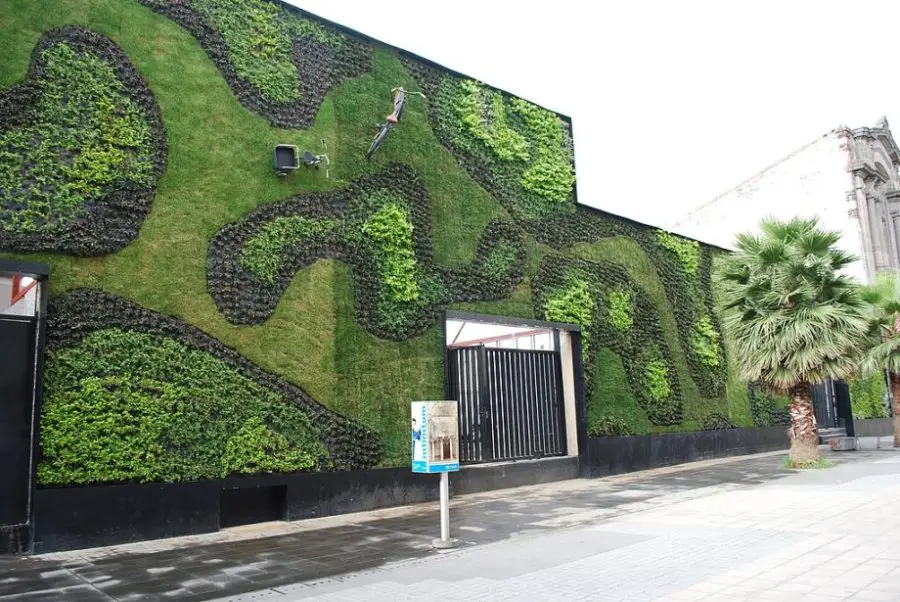
Living walls, also known as vertical gardens, are walls either partially or completely covered with vegetation.
They usually incorporate a growing medium like soil or a substrate and often include an integrated water delivery system.
Living walls bring a slice of nature to the urban jungle, beautifying concrete structures and improving air quality.
Ecological Approach in Urban Environments
Green roofs and living walls are more than just decorative features; they are critical components in ecological urban design.
By integrating natural elements into buildings, they help reduce the urban heat island effect, a common problem in cities where concrete and asphalt significantly increase temperatures.
This green infrastructure supports biodiversity in urban settings, providing habitats for various species.
Moreover, they play a significant role in stormwater management, absorbing rainwater and reducing runoff, which can alleviate pressure on urban drainage systems.
In addition, green roofs and living walls improve air quality by filtering pollutants and producing oxygen, making urban environments healthier for residents.
Their presence also offers psychological and emotional benefits, enhancing mental well-being by offering natural spaces for relaxation and recreation in densely populated areas.
This approach to urban design reflects a growing awareness of the importance of sustainable, environmentally friendly practices in city planning and architecture.
Types and Designs of Green Roofs

Green roofs come in various types, each designed to suit different urban settings and architectural needs.
From extensive to intensive and hybrid systems, these green roofs offer diverse solutions for integrating nature into urban landscapes.
Understanding their types and designs is crucial for architects, planners, and homeowners alike.
Green roofs — also known as ‘vegetated roofs’ or ‘living roofs’ — are ballasted roofs consisting of a waterproofing membrane, growing medium (soil) and vegetation (plants) overlying a traditional roof. Well-designed, engineered and maintained green roofs provide multiple environmental, social, economic and aesthetic benefits. gsa.gov
Extensive Green Roofs: Features and Suitability
Extensive green roofs are characterized by their low maintenance and shallow growing mediums, typically ranging from 2 to 6 inches in depth.
These roofs are primarily designed for environmental benefits rather than human access.
They usually feature hardy, drought-resistant plants like sedums or native grasses that require minimal care.
Extensive green roofs are lightweight, making them suitable for a wide range of buildings, including older structures that might not support heavier loads.
They’re ideal for large-scale applications such as commercial buildings or expansive residential complexes where direct access to the roof is not a primary concern.
Their primary benefits include enhanced building insulation, stormwater management, and creating biodiversity hotspots in urban areas.
Intensive Green Roofs: Characteristics and Uses
Intensive green roofs, often referred to as rooftop gardens, are thicker and can support a wider variety of plants, including shrubs and small trees.
These roofs require a deeper growing medium, typically over 8 inches, and more maintenance, similar to a traditional garden.
Intensive green roofs are designed for recreational purposes, providing accessible green spaces for relaxation and social interaction.
They are well-suited for urban settings where ground-level green space is limited, offering a sanctuary in the sky.
These systems are heavier and require stronger structural support, making them more common in newer buildings or those specifically designed to accommodate the additional weight.
The benefits of intensive green roofs extend beyond environmental advantages to enhancing the quality of life for residents and employees in urban settings.
Hybrid Green Roofs: Combining the Best of Both Worlds
Hybrid green roofs integrate elements of both extensive and intensive systems, offering a balanced solution.
These roofs feature areas of lightweight, low-maintenance extensive greenery, alongside more intensively managed sections with a wider range of plant species.
This design allows for ecological diversity and usability without the need for extensive structural reinforcements.
Hybrid systems are adaptable and can be customized to meet specific aesthetic and functional needs.
They are suitable for various urban settings, from residential buildings to commercial complexes, providing flexibility in design and usage.
Hybrid green roofs offer the ecological benefits of extensive roofs with the recreational and aesthetic appeal of intensive systems, making them a versatile choice in urban green roof design.
Each type of green roof serves a unique purpose in urban sustainability, playing a vital role in enhancing the ecological, aesthetic, and social dimensions of city living.
Types and Designs of Living Walls
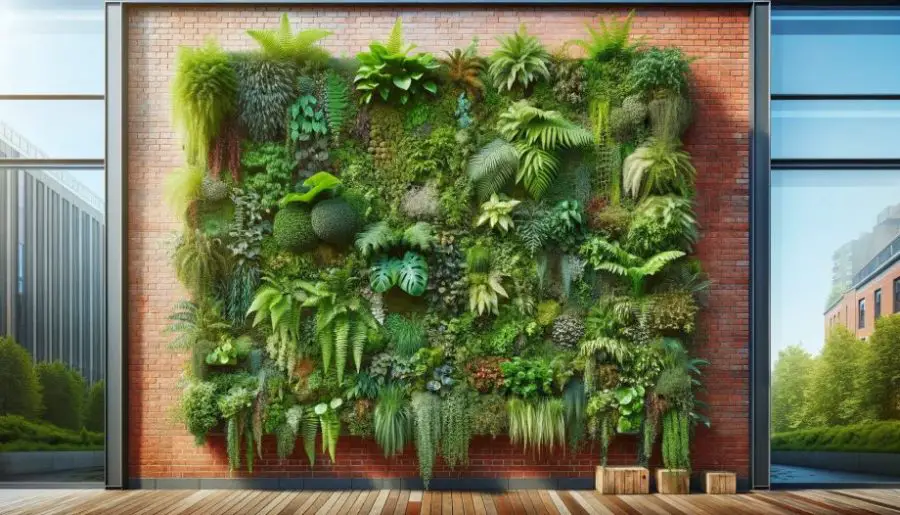
Living walls, or vertical gardens, offer a creative and efficient way of integrating greenery into urban spaces.
Whether it’s through soil-based, hydroponic, or hybrid systems, these living walls transform bland structures into vibrant, life-supporting walls.
Each system has unique features and benefits, making them suitable for various urban applications.
A green wall is a vertical built structure intentionally covered by vegetation.[1][2] Green walls include a vertically applied growth medium such as soil, substitute substrate, or hydroculture felt; as well as an integrated hydration and fertigation delivery system.[1] They are also referred to as living walls or vertical gardens, and widely associated with the delivery of many beneficial ecosystem services. From Wikipedia
Soil-Based Living Walls: Nature’s Own System
Soil-based living walls use natural soil as the growing medium for plants.
This traditional approach mimics natural growth conditions, allowing a wide variety of plants to thrive.
The soil not only provides nutrients but also retains water, reducing the need for frequent irrigation.
These systems are often heavier and require robust support structures.
Soil-based living walls are ideal for outdoor settings where weight is not a constraint, such as ground-level exterior walls or large public spaces.
They create a natural habitat for local flora and fauna, supporting urban biodiversity.
Additionally, they offer excellent insulation properties, helping to regulate building temperatures naturally.
Hydroponic Living Walls: Advancements in Vertical Gardening
Hydroponic living walls, in contrast, utilize a soil-free system where plants receive nutrients through a water-based solution.
This method allows for greater control over nutrient delivery, making it efficient and reducing the risk of soil-borne diseases.
These systems are lighter and more adaptable, suitable for indoor environments or locations where weight is a concern.
The hydroponic approach is popular in modern, urban settings, particularly for interior décor or in office buildings where space is at a premium.
Besides their aesthetic appeal, hydroponic walls also improve indoor air quality by filtering and oxygenating the air.
Hybrid Living Walls: Integrating Soil-Based and Hydroponic Systems
Hybrid living walls combine the best aspects of soil-based and hydroponic systems.
They might use a mix of soil or coco coir and perlite for natural growth and hydroponic elements for nutrient delivery, offering flexibility in plant choices and system design.
These systems are adaptable to various environments, from residential to commercial spaces.
Hybrid living walls can be tailored to specific aesthetic preferences or functional requirements, making them a versatile option for urban greening.
They offer the ecological benefits of soil-based systems along with the modern efficiency and adaptability of hydroponic setups.
In urban areas, living walls not only enhance the visual appeal of buildings but also contribute to environmental health and human well-being.
Their ability to fit into diverse urban spaces makes them an integral part of sustainable city design.
Benefits and Challenges of Green Roofs and Living Walls

In this section, we dig into the myriad benefits and the challenges associated with green roofs and living walls.
These innovative structures are not just visually appealing; they offer significant environmental, health, and social advantages.
However, their implementation also comes with specific challenges that need careful consideration, especially in urban environments.
Environmental Benefits of Green Roofs and Living Walls
Green roofs and living walls are more than just aesthetic enhancements.
They play a crucial role in improving urban environments.
From mitigating the urban heat island effect to enhancing air quality, supporting biodiversity, and aiding in stormwater management, their environmental benefits are substantial and multifaceted.
Mitigating the Urban Heat Island Effect
One of the most significant environmental benefits of green roofs and living walls is their ability to mitigate the urban heat island (UHI) effect.
This phenomenon occurs when urban areas experience higher temperatures than their rural surroundings due to the extensive use of concrete, asphalt, and other heat-absorbing materials in construction.
Green roofs and living walls counter this effect by providing natural insulation. The plants and soil on these green structures absorb and reflect sunlight, leading to lower surface and air temperatures.
This natural cooling effect can significantly reduce the need for air conditioning in buildings, thereby reducing energy consumption and associated greenhouse gas emissions.
Urban areas usually experience the urban heat island (UHI) effect, that is, they are significantly warmer than surrounding rural areas. The temperature difference is usually larger at night than during the day,[1] and is most apparent when winds are weak, under block conditions, noticeably during the summer and winter. The main cause of the UHI effect is from the modification of land surfaces while waste heat generated by energy usage is a secondary contributor. From Wikipedia
Improving Air Quality
Green roofs and living walls also contribute to improved air quality.
Plants naturally filter pollutants and particulates from the air, which is particularly beneficial in urban areas with high levels of vehicular and industrial emissions.
Through the process of photosynthesis, these green installations also produce oxygen, further enhancing the air quality.
By integrating green roofs and living walls into urban landscapes, cities can create healthier environments for their residents, reducing the risks associated with air pollution, such as respiratory issues and cardiovascular diseases.
Enhancing Biodiversity
Biodiversity enhancement is another key environmental benefit.
Green roofs and living walls provide habitats for a variety of organisms, including birds, insects, and small mammals.
In urban areas, where natural habitats are often scarce, these green structures offer a refuge for wildlife, promoting ecological diversity and balance.
They can serve as stepping stones or corridors for urban wildlife, facilitating movement and interaction among different species.
Stormwater Management
Lastly, green roofs and living walls play a vital role in stormwater management.
They absorb rainfall, reducing runoff and easing the burden on urban drainage systems.
This absorption also helps filter pollutants from rainwater, improving the quality of water that eventually reaches rivers and streams.
By retaining rainwater, these structures also help in recharging groundwater levels and preventing urban flooding, making cities more resilient to climate change impacts.
Green roofs and living walls thus offer a multifaceted approach to enhancing urban ecology.
Their implementation not only beautifies cityscapes but also contributes significantly to environmental sustainability.
Health and Social Benefits of Green Roofs and Living Walls
Beyond their environmental advantages, green roofs and living walls significantly impact public health and social well-being.
These green spaces in urban environments contribute to healthier, more equitable, and cohesive communities.
Improving Public Health
Green roofs and living walls have a direct positive impact on public health.
By reducing air pollution, they lower the risk of respiratory diseases, such as asthma, and other health issues related to poor air quality.
The presence of plants also contributes to noise reduction.
Dense foliage and soil layers act as natural sound insulators, absorbing and deflecting urban noise, which can otherwise be a significant stressor in densely populated areas.
This noise mitigation leads to quieter, more serene urban environments, which is essential for mental health and well-being.
Enhancing Mental Well-Being
The mental health benefits of green roofs and living walls are profound.
Exposure to green spaces has been consistently linked to reduced stress levels, improved mood, and overall psychological well-being.
These spaces provide urban dwellers with a much-needed connection to nature, which can be scarce in city settings.
The presence of natural elements in daily life can reduce feelings of anxiety and depression, foster relaxation, and improve cognitive function, including attention and memory.
Contributing to Social Equity and Community Cohesion
Green roofs and living walls can also play a significant role in enhancing social equity and community improvement.
By providing accessible green spaces, especially in underprivileged urban areas lacking natural landscapes, these installations can help bridge the gap in environmental quality across different socio-economic groups.
They offer communal spaces for social interaction, recreation, and community gardening, fostering a sense of community and belonging.
Such inclusive spaces encourage diverse groups to come together, promoting social cohesion and community resilience.
The health and social benefits of green roofs and living walls underline their importance as more than just architectural features.
They are essential components in building healthier, more equitable, and interconnected urban communities.
Challenges and Considerations of Green Roofs and Living Walls
While green roofs and living walls offer numerous benefits, their implementation comes with certain challenges and considerations.
Understanding these aspects is crucial for their effective and sustainable integration into urban environments.
Installation Costs and Maintenance Needs
One of the primary challenges of installing green roofs and living walls is the initial cost.
The expense includes not only the materials and plants but also potentially reinforcing existing structures to support the additional weight, especially for intensive green roofs.
Maintenance is another ongoing consideration.
While extensive green roofs require minimal upkeep, intensive green roofs and certain types of living walls need regular care, including watering, pruning, and monitoring for pests and diseases.
These maintenance needs incur additional costs and require dedicated resources, which can be a barrier for some projects.
Long-Term Sustainability
The long-term sustainability of green roofs and living walls is contingent on proper design and installation.
Factors such as choosing the right plants for the local climate, ensuring adequate drainage, and using sustainable materials all play a role in the longevity of these green installations.
Failure to address these factors can lead to higher maintenance costs, reduced lifespan, and potentially, the failure of the green infrastructure.
Urban Planning and Design Considerations
Effective implementation of green roofs and living walls also requires careful urban planning and design.
Planners and architects must consider factors like building orientation, local climate, and intended use of the space.
In urban areas, integrating these green structures into existing buildings can be particularly challenging, requiring innovative solutions to accommodate space and weight limitations.
Despite these challenges, with proper planning, design, and maintenance, green roofs and living walls can be valuable additions to urban landscapes, providing environmental, health, and social benefits.
Green Roofs and Living Walls FAQs
Green roofs and living walls often spark curiosity and interest.
Here are some frequently asked questions that delve into their nature, benefits, challenges, and more, providing you with a deeper understanding of these innovative green solutions.
Q. What are green roofs and living walls?
A. Green roofs are layers of vegetation planted over a waterproofing system on a building’s roof.
Living walls, also known as green walls or vertical gardens, are walls partially or completely covered with vegetation, including a growing medium like soil or a substrate.
Q. What is the main disadvantage of green roofs?
A. The main disadvantage of green roofs is their high initial installation cost, especially for intensive green roofs that require significant structural support.
Ongoing maintenance and the need for proper waterproofing and drainage systems are also considered challenges.
Q. What are the benefits of green walls and roofs?
A. Green walls and roofs offer environmental benefits like reducing the urban heat island effect, improving air quality, and aiding in stormwater management.
They also enhance biodiversity, provide mental health benefits, and can improve the aesthetic appeal of urban areas.
Q. What is the difference between a green facade and a living wall?
A. A green facade is typically made up of climbing plants growing directly on the wall or on specially designed supporting structures.
In contrast, a living wall has plants growing in a medium attached to the wall, offering more design flexibility and plant variety.
Q. What is the difference between a green wall and a green roof?
A. The main difference is their orientation. Green roofs are horizontal installations on the top of buildings, while green walls are vertical installations on the sides of buildings.
Both serve to incorporate greenery into urban architecture but in different spatial dimensions.
Q. What is the downside of green walls?
A. The downside of green walls includes the need for a consistent maintenance regime, potential water damage if not properly installed, and the requirement for a suitable irrigation system.
They also require careful planning and plant selection to thrive in their vertical orientation.
Conclusion: Embracing Green Futures in Urban Development
In conclusion, green roofs and living walls are more than just aesthetic enhancements for urban environments; they are vital components in the quest for sustainable urban development.
These living installations offer a multitude of benefits, including environmental improvements, health and wellness enhancements, and social and community advancements.
By mitigating the urban heat island effect, improving air quality, and fostering biodiversity, green roofs and living walls address some of the most pressing challenges of modern urban life.
They also contribute significantly to the mental and emotional well-being of city dwellers, offering serene, green spaces amidst the concrete landscape.
The Vital Role of Green Roofs and Living Walls
In our pursuit of sustainable urban environments, green roofs and living walls stand out as more than just aesthetic enhancements.
They are integral to addressing the environmental challenges of urban areas.
By tackling issues like the urban heat island effect and air pollution, these living systems contribute significantly to creating healthier urban spaces.
Enhancing Urban Well-Being and Biodiversity
Their impact extends beyond environmental benefits, touching on the mental and emotional well-being of city residents.
Offering serene green retreats amidst urban landscapes, green roofs, and living walls plays a crucial role in improving the quality of life in densely populated areas.
They also promote biodiversity, turning urban spaces into havens for various plant and animal species.
Future Urban Planning: Integrating Nature with Architecture
As we look to the future, the integration of green roofs and living walls in urban planning and architecture is essential.
These systems represent a progressive approach to urban development, combining sustainability with innovative design.
Their incorporation is key to building more resilient, liveable, and aesthetically pleasing urban environments.
A Call to Action for Greener Cities
Let us embrace the potential of green roofs and living walls in our future urban projects.
Their adoption is not just an investment in environmental sustainability but also a commitment to enhancing the well-being of urban dwellers.
As we navigate the challenges of urban growth, these green systems offer a path toward a harmonious and sustainable coexistence with nature in our cities.
The Future of Green Roofs and Living Walls
As we move forward, urban planners, architects, and developers must consider integrating green roofs and living walls into their projects.
These systems not only enhance the sustainability and livability of urban areas but also represent a forward-thinking approach to city planning and design.
They are a testament to the possibilities of harmoniously blending nature with the built environment, creating healthier, more resilient, and more beautiful cities for future generations.
As we continue to navigate the complexities of urban growth and environmental conservation, let us embrace green roofs and living walls as essential elements of our urban future.
Their integration into our cities is not just a nod to innovation but a commitment to a greener, more sustainable world.

